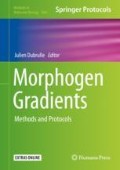Abstract
We describe methods for detecting and quantifying the concentration gradient of the morphogenetic protein Bicoid through fluorescent immunostaining in fixed Drosophila embryos. We introduce image-processing steps using MATLAB functions, and discuss how the measured signal intensities can be analyzed to extract quantitative information. The described procedures permit robust detection of the endogenous Bicoid concentration gradient at a cellular resolution.
Access this chapter
Tax calculation will be finalised at checkout
Purchases are for personal use only
References
Driever W, Nusslein-Volhard C (1988) A gradient of bicoid protein in Drosophila embryos. Cell 54(1):83–93
Driever W, Nusslein-Volhard C (1988) The bicoid protein determines position in the Drosophila embryo in a concentration-dependent manner. Cell 54(1):95–104
Liu J, He F, Ma J (2011) Morphogen gradient formation and action: insights from studying Bicoid protein degradation. Fly 5(3):242–246
Ma J, He F, Xie G, Deng WM (2016) Maternal AP determinants in the Drosophila oocyte and embryo. Wiley Interdiscip Rev Dev Biol 5(5):562–581. https://doi.org/10.1002/wdev.235
He F, Wen Y, Deng J, Lin X, Lu LJ, Jiao R, Ma J (2008) Probing intrinsic properties of a robust morphogen gradient in Drosophila. Dev Cell 15(4):558–567. https://doi.org/10.1016/j.devcel.2008.09.004
Gregor T, Tank DW, Wieschaus EF, Bialek W (2007) Probing the limits to positional information. Cell 130(1):153–164
Reinitz J (2007) Developmental biology: a ten per cent solution. Nature 448(7152):420–421
Crauk O, Dostatni N (2005) Bicoid determines sharp and precise target gene expression in the Drosophila embryo. Curr Biol 15(21):1888–1898
He F, Wen Y, Cheung D, Deng J, Lu LJ, Jiao R, Ma J (2010) Distance measurements via the morphogen gradient of Bicoid in Drosophila embryos. BMC Dev Biol 10:80. https://doi.org/10.1186/1471-213X-10-80
He F, Ren J, Wang W, Ma J (2011) A multiscale investigation of bicoid-dependent transcriptional events in Drosophila embryos. PLoS One 6(4):e19122. https://doi.org/10.1371/journal.pone.0019122
Kosman D, Small S, Reinitz J (1998) Rapid preparation of a panel of polyclonal antibodies to Drosophila segmentation proteins. Dev Genes Evol 208(5):290–294
Patel NH, Hayward DC, Lall S, Pirkl NR, DiPietro D, Ball EE (2001) Grasshopper hunchback expression reveals conserved and novel aspects of axis formation and segmentation. Development 128(18):3459–3472
Liu J, Ma J (2011) Fates-shifted is an F-box protein that targets Bicoid for degradation and regulates developmental fate determination in Drosophila embryos. Nat Cell Biol 13(1):22–29. https://doi.org/10.1038/ncb2141
Cheung D, Ma J (2015) Probing the impact of temperature on molecular events in a developmental system. Sci Rep 5:13124. https://doi.org/10.1038/srep13124
He F, Saunders T, Wen Y, Cheung D, Jiao R, ten Wolde P, Howard M, Ma J (2010) Shaping a morphogen gradient for positional precision. Biophys J 99:697–707 PMCID: PMC2913175
Cheung D, Miles C, Kreitman M, Ma J (2011) Scaling of the Bicoid morphogen gradient by a volume-dependent production rate. Development 138(13):2741–2749. https://doi.org/10.1242/dev.064402
Cheung D, Miles C, Kreitman M, Ma J (2014) Adaptation of the length scale and amplitude of the Bicoid gradient profile to achieve robust patterning in abnormally large Drosophila melanogaster embryos. Development 141(1):124–135. https://doi.org/10.1242/dev.098640
He F, Wei C, Wu H, Cheung D, Jiao R, Ma J (2015) Fundamental origins and limits for scaling a maternal morphogen gradient. Nat Commun 6:6679. https://doi.org/10.1038/ncomms7679
Liu J, Ma J (2015) Modulation of temporal dynamics of gene transcription by activator potency in the Drosophila embryo. Development 142:3781–3790. PMCID: PMC4647213. https://doi.org/10.1242/dev.126946
Liu J, Ma J (2013) Dampened regulates the activating potency of Bicoid and the embryonic patterning outcome in Drosophila. Nat Commun 4:2968. PMCID: PMC3902774. https://doi.org/10.1038/ncomms3968
Wu H, Manu JR, Ma J (2015) Temporal and spatial dynamics of scaling-specific features of a gene regulatory network in Drosophila. Nat Commun 6:10031. PMCID: PMC4686680. https://doi.org/10.1038/ncomms10031
Acknowledgments
The protocol described in this chapter was developed at the Cincinnati Children’s Hospital Research Foundation. We acknowledge the invaluable contributions of Ying Wen in developing the protocol. FH acknowledges support of Institute of Apicultural Research, Chinese Academy of Agricultural Sciences. HW acknowledges the generous support of his current supervisor Dr. Renjie Jiao. JM is a National “Thousand Talents” Scholar of China and acknowledges support of Zhejiang University. Feng He and Honggang Wu contributed equally to this work.
Author information
Authors and Affiliations
Corresponding author
Editor information
Editors and Affiliations
Rights and permissions
Copyright information
© 2018 Springer Science+Business Media, LLC, part of Springer Nature
About this protocol
Cite this protocol
He, F., Wu, H., Cheung, D., Ma, J. (2018). Detection and Quantification of the Bicoid Concentration Gradient in Drosophila Embryos. In: Dubrulle, J. (eds) Morphogen Gradients. Methods in Molecular Biology, vol 1863. Humana Press, New York, NY. https://doi.org/10.1007/978-1-4939-8772-6_2
Download citation
DOI: https://doi.org/10.1007/978-1-4939-8772-6_2
Published:
Publisher Name: Humana Press, New York, NY
Print ISBN: 978-1-4939-8771-9
Online ISBN: 978-1-4939-8772-6
eBook Packages: Springer Protocols

